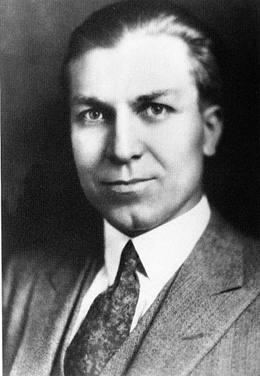Builder and contractor Frederick William Anhalt produced some of Seattle’s most noteworthy apartment buildings in the years immediately surrounding the Great Depression.
Early Years
Born in Minnesota, Anhalt had no formal architectural education. From age 14 to 28, he worked within grocery and butcher businesses throughout the Midwest. He came to the building trades and real estate development from a general interest in business and innovation. Anhalt worked briefly as a salesman in Seattle around 1925; this led to an interest in leasing commercial space.
In 1925, Anhalt established a development organization with Jerome B. Hardcastle, a former butcher. By the next year, their Western Building & Leasing Company began constructing new buildings. Anhalt interacted directly with the work of contract architects and skilled builders, gaining interest in design as his company grew. In 1928, he bought out Hardcastle’s share of the business and soon established a focus that would become synonymous with Anhalt’s name: the luxury apartment building. The first developments overseen by Anhalt varied. These were commercial and residential, including bungalow apartments and single family houses in many Seattle neighborhoods. The style of these early buildings varied as well, but all were revivals of historical styles.
Anhalt's Historical Styles
Borrowing elements of historic building styles was popular in the late nineteenth and early twentieth century. In the case of Anhalt’s apartment buildings, designers took aspects of earlier European architecture and applied them to new buildings. Often, the buildings had wooden frames clad in the style of choice. Elements that were once structural, like the half-timbering of Tudor or Elizabethan-style houses in England, were applied to the exteriors of Tudor Revival buildings as decorative elements. When Anhalt joined with Mark B. Borchert to develop luxury apartment buildings in Seattle, the team used Tudor elements and volumes. Examples of these include:
- 1405 E John Street, Berkeley Court, renamed Anhalt Arms in 2004 (1928)
- 1516 East Republican Street, now Twin Gables (1928-1929)
- 750 Belmont Avenue East, now Belmont Court (1929-1930)
- 1014 East Roy Street (1929-1930)
The building at 1014 East Roy Street was one of the most elaborate designs associated with Anhalt’s company. Its scale and Tudor Revival style, combined with high quality construction, suggested the ideals of his firm. In 1930, Anhalt promoted the mission of his company in “Apartments by Anhalt,” an in-house publication.
Great Depression
Anhalt completed his four largest apartment buildings after the stock market crash of 1929, but his company soon went bankrupt. He continued smaller scale contracting work. In the decade following his company’s insolvency, Anhalt built custom and speculative houses, many in the Colonial Revival mode, incorporating elements from early American architecture, a trend gaining momentum in the 1920s and 1930s in Seattle and nationwide. He left construction and development in 1942. Although Anhalt was not an architect, he contributed substantially to Seattle’s residential architecture in the 1920s and 1930s. In 1993, the Seattle Chapter of the American Institute of Architects (AIA) saluted him with an honorary membership.

